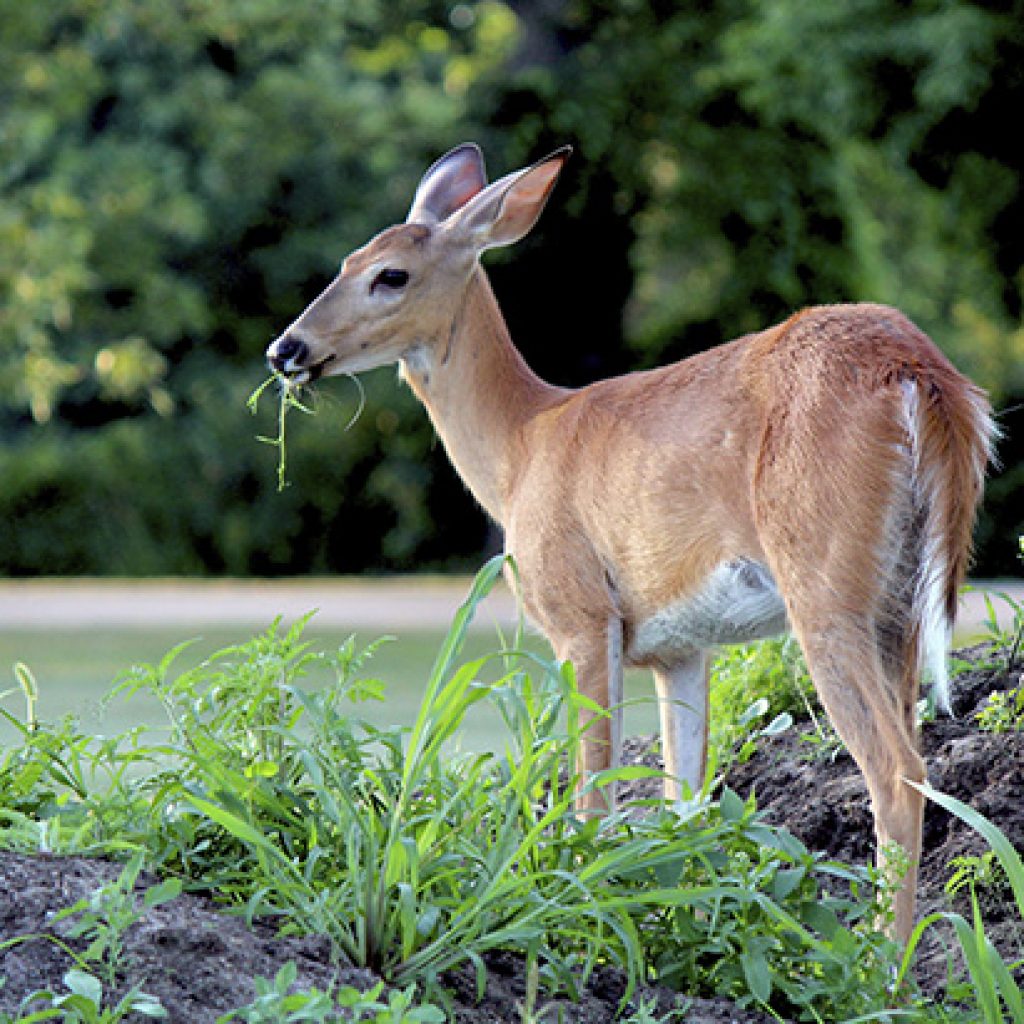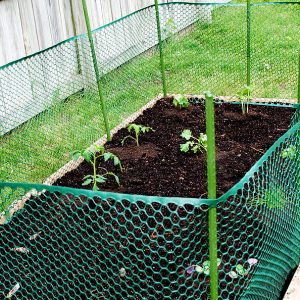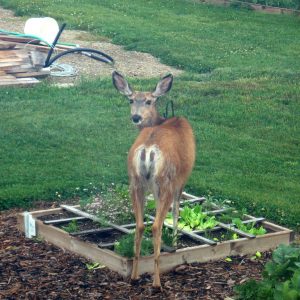Deer Deterrent Ideas for Your Garden
 Deer Deterrent Ideas for Your Garden
thegearhunt.com
Deer Deterrent Ideas for Your Garden
thegearhunt.com
When it comes to gardening, deer can pose a set of challenges that are unique. For those of us who have experienced this battle, we know that when it comes to having a flourishing garden in an area where deer thrive, it can be difficult. Those adorable furry creatures seem to inherently sense which plants we love. With that in mind, let’s talk about how to deer proof your garden.
 The population of white-tailed deer in the east, as well as the population of mule deer in the west, continue to grow, and so does suburbia, and because of this, deer are becoming more and more of a problem for gardeners. Each herd will eat differently, so gardening, while there are deer in the area, can take a lot of experimentation and patience. Above all, it also requires the willingness to have a bit of flexibility in your choices of plants as well as with your techniques for managing the deer. What works for one person might be ineffective for someone else. You might even want to use a combination of things and remain vigilant when it comes to finding out which ones are the most effective for you. You may come to find that what works one season might not work the next, and you will need to tweak your approach again.
The population of white-tailed deer in the east, as well as the population of mule deer in the west, continue to grow, and so does suburbia, and because of this, deer are becoming more and more of a problem for gardeners. Each herd will eat differently, so gardening, while there are deer in the area, can take a lot of experimentation and patience. Above all, it also requires the willingness to have a bit of flexibility in your choices of plants as well as with your techniques for managing the deer. What works for one person might be ineffective for someone else. You might even want to use a combination of things and remain vigilant when it comes to finding out which ones are the most effective for you. You may come to find that what works one season might not work the next, and you will need to tweak your approach again.
Choose Plants that are Resistant to Deer
This one might seem to be common sense, but you might be surprised at the number of gardeners who complain that the deer eat their favorite plant. If the deer eat it, then replace it with something else. There are seemingly endless choices available.
The first line of defense when it comes to gardens and deer is always going to be choosing your plants wisely. NEVER put a plant in the garden if it doesn’t have one of the following:
Hairy or fuzzy foliage. Before you purchase a plant for your garden, just rub a bit of the foliage against your skin. If you can feel that the leaves have small hairs, whether or not they are bristly, it will more than likely be a good choice for a garden that you want to be deer proof. Deer are not fond of hairy or fuzzy textures on their tongues. Garden plants that are resistant to deer in this category include things like purple top vervain, poppies, ageratum, yarrow, heliotrope, tuberous begonias, flowering tobacco, Siberian bugloss, lady’s mantle, lambs’ ear, and many more.
Prickly foliage. Deer also don’t care for plants that have spiny leaves. Some deer will learn to eat around them though, but they tend to avoid them for the most part. Plants in this category include things like sea hollies, Cardoon, globe thistle, bear’s breeches, and many more.
Foliage that has a heavy scent. Just as we do, deer eat first with their noses. If something doesn’t have a good smell, they will be less likely to eat it. Plants that have foliage that is heavily scented confuse the olfactory systems of the deer and can discourage them from feeding. This makes plants of this nature great for gardens that you want to be deer proof. Some of the plants in this category include things like calamine, lantana, dill, blue mist shrub, dead nettle, mountain mint, bee balm, tansy, Salvias, boxwood, Russian sage, Artemisia, hyssop, catmint, and more.
Foliage that is toxic. Among the list of deer-resistant plants are ones that contain things that are toxic to the deer. Mothers teach their fawns which plants they should stay away from, but they also learn from experience. For example, all ferns contain things that deer aren’t able to tolerate. So do things like poppies, spurges, monkshood, hellebores, daffodils, bleeding hearts, and false indigo. Plant these with caution though, because they can also be toxic to pets and humans who decide to taste them.
Fibrous or leathery foliage. Deer also tend to avoid those plants that are difficult for them to digest. In this category are things like some variations of viburnums, peonies, elephant ears, dragon wing and wax begonias, most irises, and pachysandra, among others.
Grasses. When it comes to what deer prefer, they tend to go for the woody plant shoots and flowering plants more than grasses. That being said, some of their diet does include young grasses that are succulent. However, white tailed deer are not able to survive on just grasses and will only eat it when they have nothing else to eat. Due to this fact, when you are looking for ways to deer proof your garden, ornamental grasses are a fantastic option.
Fencing
 When it comes to deer proofing your garden, fences are a necessity. This is the only way to really keep them from devouring your plants. However, erecting a great deer fence can be cost prohibitive, and by the time you have finished, you might just feel as if you have succeeded in fencing yourself in as opposed to keeping the deer out. Remember that deer have the capability of leaping an 8-foot-tall fence, so yours will need to be at least that tall.
When it comes to deer proofing your garden, fences are a necessity. This is the only way to really keep them from devouring your plants. However, erecting a great deer fence can be cost prohibitive, and by the time you have finished, you might just feel as if you have succeeded in fencing yourself in as opposed to keeping the deer out. Remember that deer have the capability of leaping an 8-foot-tall fence, so yours will need to be at least that tall.
Here are some helpful tips for fencing and deer.
Stockade fences tend to be more effective than fences that the deer are able to see through. Deer don’t like jumping over things unless they are able to see what is on the other side. This means that if you get a stockade fence, it won’t need to be as tall as fences that they can see through. Stockade fences that are about 6 feet tall work great.
Sometimes, the best option for fencing is to not have one. When was the last time you went to the zoo? If it was recently, you may have noticed that some of them now keep the animals separate with wide borders of irregularly shaped, large rocks as opposed to fencing. They do this because animals with hooves won’t be able to walk over rocky, unstable areas. Remember that deer also have hooves. Creating a border that is 6 – 8 feet wide with rocks of this type around your garden can keep the deer out. Your rock bed will need to be wide so that the deer won’t be able to just jump over it.
Electricity. Electric fences are yet another way to keep the local deer from your garden. Check with authorities in your area though to ensure that they are allowed. Before you install an electric fence, check the zoning laws in the area. When it comes to installing this type of fence, you can do it yourself or hire a fencing company to do it. If you choose to undertake this task yourself, ensure that you read, understand, and follow all of the directions carefully. When it comes to electric deer fencing, they can be the type you plug in or solar powered. It doesn’t matter which type you choose but be advised that the fence line will need to be regularly maintained so that weeds and plants don’t come into contact with it and render it ineffective. Remember that electric fences can give you quite a large shock, so you will need to be careful when you are working near them. If you have small children, they should be avoided completely. While this type of fencing isn’t everyone’s cup of tea, they do tend to be rather effective for deer proofing gardens, especially when they are installed properly and well maintained.
Fences with double layers work great. Deer tend to not like jumping into spaces that are enclosed because it can make them feel as if they are trapped. Due to this, double fencing can be quite an effective tool when it comes to protecting your garden from being damaged. You might surround your yard or garden with a picket fence that is about 5 feet tall and then put a second one about 5 feet inside of that one. Your inner fence might be made from wire lines, chicken wire, box wire, or any other material that is less expensive. Deer don’t have very good depth perception and they won’t try to leap both fences simultaneously.
 Use deer netting that is ‘invisible’. This is probably the most common type of deer fencing. Just fasten black mesh deer netting to wood 4 x 4s or to T-bar metal garden posts. It needs to be a minimum of 8 feet tall in order to be effective. For a while after you have erected this fence, you might want to tie a few colorful streamers or strings to it so that the deer won’t run through it by accident if they happen to get spooked.
Use deer netting that is ‘invisible’. This is probably the most common type of deer fencing. Just fasten black mesh deer netting to wood 4 x 4s or to T-bar metal garden posts. It needs to be a minimum of 8 feet tall in order to be effective. For a while after you have erected this fence, you might want to tie a few colorful streamers or strings to it so that the deer won’t run through it by accident if they happen to get spooked.
Fencing individual plants. Maybe you don’t want to have to put a fence around your entire garden. If this is the case, you might fence a few of the individual plants. If this is your choice, you can keep them covered with a layer of deer netting.
Deer Repellents
People might think that deer sprays aren’t that effective. However, it depends on how you use them. If you want to achieve fantastic results with products of this nature, you have to use them religiously. You can’t just go out to your garden, spray it once, and then forget about it. They should be applied once a week minimum. You only need to apply it to your plants that aren’t naturally resistant to deer. They can work wonders if you consistently use them.
Here are a few tips for the effective use of deer repellents.
Nearly all of the deer repellents on the market work because they use a combination of taste and odor deterrents. Due to this, most of these products will have an unpleasant smell, or they will until they dry. Just remember that being consistent with them is more important than their ingredients.
Some of the deer deterrents contain some sort of spreader-sticker additive. This makes it remain stuck on the plant leaves longer, and they work great on shrubs and trees during the colder months. These should be used in winter and spring because this is the time of year when the deer tend to get closer to houses to forage. These deterrents will leave behind a white residue, but it tends to be worth it because you won’t need to use them as often.
Most often, deer repellents are made from things like soaps, garlic, dried blood, and putrefied eggs. There have been quite a few studies that have found that products that are egg based tend to be the most effective. Some of these include Liquid Fence, Bobbex, and Deer Away. A good soap based one is Hinder, and a good blood based one is Plantskydd.
There are also clip on, hanging, and granular types of deer repellents, but there haven’t been too many independent studies on them that show that they are as effective as their spray counterparts. You might not want to take the risk of damaging your plants to try them.
Deer deterrents that have a limited effectiveness include things like predator urine, bags of hair, bars of soap, and other items of this nature. They might work for a small period of time and in small areas, but given time, the deer get used to them and will come to ignore them.
Scare Them
 When it comes to scaring deer, motion activated sprinklers work wonders. However, they aren’t all created equal. Motion activated sprinklers will deliver a burst of water right towards where ever they detected motion. This scares the deer and they run away. The range of the arms of the sprinkler can be adjusted so that it will target a specific area, which means they are perfect for protecting flower beds, individual shrubs, or vegetable gardens. Here are a couple of tips on using them.
When it comes to scaring deer, motion activated sprinklers work wonders. However, they aren’t all created equal. Motion activated sprinklers will deliver a burst of water right towards where ever they detected motion. This scares the deer and they run away. The range of the arms of the sprinkler can be adjusted so that it will target a specific area, which means they are perfect for protecting flower beds, individual shrubs, or vegetable gardens. Here are a couple of tips on using them.
While these are effective throughout the growing season, when the weather turns cold, they are ineffective. This is because the hoses can freeze. If you will be using these, be advised that they will need to be properly drained and stored through the winter.
While a single sprinkler can protect small to medium gardens, for larger ones, you will need more.
For the ultimate protection, move the sprinkler to different spots every couple of days.
Unless you plan to engage a horde of border collies to protect your garden, using a combination of the things listed above to deter deer will be the smartest and largest step towards deer proofing your garden.
Sources
- Youtube, How to Keep Deer Out of Your Garden
- Electronic Pest Control Pro, Deer Repeller Pro
- Dummies, How to Keep Deer Out of Your Garden
- Bonnie Plants, Keeping Deer Out of the Garden
















